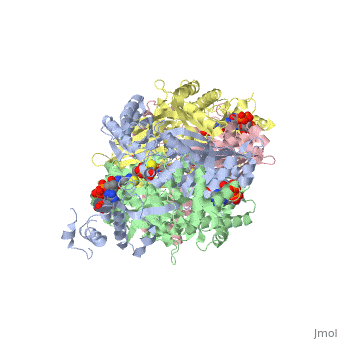SB2013 L08gr01
From Proteopedia
Significance of OspC in Lyme Disease
| |||||||||||
Lyme disease is a progressive multisystem disorder that produces a primary infection (erythema migrans), at an early stage, at the site of bite by Ixodes tick carrying spirochetes (Borrelia burgdoferi) and may spread to secondary sites (e.g. heart, nervous system, joints), if left untreated. Outer Surface Proteins (e.g. OspA, OspB and OspC) play a vital role in this infection process. While inside the vector, presence of OspA is prominent while OspC is unexpressed on the spirochete outer membrane. When spirochete invades the host body, OspA is suppressed and an upregulation of OspC occurs due to an induction in OspC synthesis (the surface proteins are co-regulated on the mRNA level). This upregulation of OspC occurs partially due to differential temperature change (the optimal temperature being 32-37 degree Celsius) in the host body. However, OspC expression decreases after two days (time needed for spirochete transmission) of feeding. This implies that OspC is a vital protein supporting the transmission of the antigen in the host body (Kumaran et al. 2011). Furthermore, the tick-borne infection was shown to be prevented upon addressing active (Gilmore et al. 1996) or passive (Mbow et al. 1999) immunization with various OspC formulation in experimental mammals. As a result, OspC is th eprotein of interest that is to be studied.
The highly variable OspC gene is located on a 27 kb circular plasmid and encodes for lipprotein, which contains an 18 amino acid sequence. This amino acid sequence changes after processing and lipidation at the amino proxymal Cys residue. The high variability of OspC gene makes OspC protein very polymorphic which varies among the major groups and even within different locations (Kumaran et al. 2011). The three dimensional structure of OspC consists of five helices and to anti-parallel beta sheeet per monomer(Figre1). Not all strains of OspC are invasive to human (less than half). Even within invasive groups, the amino acid sequence varies (dissimilarities in building units), yet all of the invasive groups continue to share remarkably well reserved solvent structure (Figure 5) within the cavity (similarity in 3D structure and folding leading to similar function). Another point of significance to be added is that regions in all invasive species are likely to be partially occupied by heavy trace ios(Kumaran et al. 2001). One of the most prominent differences between OspC of invasive strands of spirochete has a strong negative electrostatic potential region which exists with in its two fold axis (Figure 2).
The importance of this negative region is immense because it is likely to have a variety of functions. Initially it has been proposed that OspC may function in the cellular adhesion of Lyme disease because of its predisposition to bind to positively charged host ligands, such as extracellular glycoproteins like fibronectin. But more recent studies have suggested that the function of OspC may be entirely different. It is now understood that OspC plays a role in immobilizing plasminigoen, suggesting that OspC is biologically relevant plasminogen receptor on the surface of B.burgdoferi. B.burgdoferi, like many bacterial pathogens, cannot produce endogenous membrane-associated proteases and has to appropriate host proteases to increase the probability of successful host colonizatio (Onder et al. 2011).
However, the existence of the negatively charged region may not be the only reason contributing the invasion Overall structure of OspC may play an equally important role. Recent studies showed that, in serum of patients demonstrationg erythma migrans (early stage of Lyme disease), IgM antibody has been found to interact with OspC (Wilske et al. 1986). On the other hand, immunoblot of serum from patients showing secondary infections has been observed to demonstrate a lower number if IgM-OspC complexes, further demonstrating the importance of OspC for the primary transmission (Dressler et al. 1993). In addtion, moderate IgG reactivity to OspC has been found in the serum of patients at an early stage of Lyme disease (Fung et al. 1994). Furthermore, supporting researches have highlighted a well-conserved immunodominant epitope located on the carboxy-terminal region of OspC demostrating the ability of binding to antibodies (Jobe et al. 2003). IgM and IgG antibodies from serum of patients at an early stage of Lym edisease get asorbed with a carboxy- terminal ( seven amino acid long) of OspC (figure 6). Surprisingly, this epitope on carboxy-terminal and its binding of antibodies is very well conserved among different invasive OspC protein (Lovrich et al. 2005).
Since OspC helps with early transmission of spirochete to the host body, it will be much more efficient to develop a vaccine based on OspC compared to the current vaccination based on OspA (Kumaraan et al. 2001). In addition, a combinatory vaccination based n both OspA and OspC may be developed to not only produce antibody in the host body responding to OspC but also disinfecting the tick while it feeds on the host body blood containing antibodies for OspA (Greenberg 2001). Nevertheless, due to high variance in structure (with invasive groups, which can even vary depending on location), it is a matter of difficulty to produce a globalized vaccination (Kumaran et al. 2001). A globalized vaccination may work by denaturing the structure of OspC and making it impossible for it to bind to host cell. A proposed target area for a vaccine may includes areas like the well-conserved immunodominant epitope present at the carboxy-terminal of OspC (Jobe et al. 2003).
Proteopedia Page Contributors and Editors (what is this?)
Sharugash Swargaloganathan, Yevgeniy Luts, Mohammad Tariq Al Fazal

